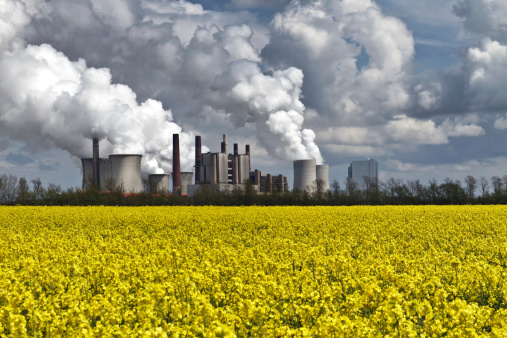
EPA’s authority to regulate greenhouse gas emissions is left largely intact, but agency faces rebuke.
“Any air pollutant.” The interpretation of this seemingly benign phrase in a federal pollution control law lay at the heart of the legal battle in a case decided Monday by the U.S. Supreme Court.
In Utility Air Regulatory Group v. Environmental Protection Agency, the Environmental Protection Agency (EPA) defended its regulation of greenhouse gases (GHGs) emitted from stationary sources against a challenge by the utility industry that argued the rule would cost $193 billion. The U.S. Supreme Court handed down its decision in the case on Monday, with the splintered majority opinion of the Court written by Justice Antonin Scalia.
The Court examined only a narrowly defined question: whether the EPA had exceeded its authority under the Clean Air Act (CAA) by determining that regulation of GHGs from motor vehicles automatically triggered permitting requirements for GHG emissions from stationary sources under other sections of the CAA.
The justices split five-to-four along ideological lines with respect to the part of the opinion holding that the EPA overreached by assuming it could regulate all sources of GHG emissions just because it has the power to regulate some of them. The opinion also chided the EPA for altering specific numerical thresholds set by Congress in the CAA.
However, another portion of the opinion supported by a seven-to-two vote of the justices held that EPA could permissibly regulate GHG emissions from stationary sources if a source was already subject to permitting requirements based on its emissions of other, more conventional air pollutants.
The dual holdings of the majority opinion essentially represent a compromise. On the one hand, as Justice Scalia stated while announcing the opinion, “EPA is getting almost everything it wanted in this case.” On the other hand, the opinion included some harsh admonitions, rebuking EPA for exceeding its statutory authority.
Despite some urgings by petitioners, the Court declined to re-examine its decision in Massachusetts v. EPA, which held that GHGs do qualify as “air pollutants” as defined in the CAA and which required the EPA to determine whether GHGs are harmful to public health and thus need to be regulated in some manner. The Court also refused to disturb the EPA’s subsequent “endangerment finding” that established that GHG emissions contribute to climate change and threaten public health. Leaving those findings intact was critical, because they are the foundation of the EPA’s authority to regulate GHG emissions.
After issuing its endangerment finding in 2009, EPA promulgated a rule setting GHG emissions standards for cars and light trucks. That rule, called the tailpipe rule, created the seeds of the controversy that led to Monday’s decision by the Supreme Court. EPA claimed that defining “any air pollutant” to include GHGs under its tailpipe rule automatically triggered a requirement to regulate such emissions from stationary sources as well. However, the agency reached this conclusion because it assumed that “any air pollutant” had to have the same definition throughout every portion of the CAA.
EPA interpreted the term “any air pollutant” to include GHGs in the two sections of the CAA at issue in this case – the Prevention of Significant Deterioration (PSD) program (designed to protect air quality in clean parts of the country) and the Title V permitting program (which addresses stationary sources). Under these two sections, Congress specified that emissions permits would be required for any facility with emissions that exceed thresholds of 100 to 250 tons per year. These thresholds work well for more conventional pollutants, like carbon monoxide, as they mean that only major industrial facilities need to obtain permits and be subjected to pollution controls. But these thresholds do not fare so well for GHGs like carbon dioxide (CO2), which are emitted in far greater quantities even by tens if not hundreds of thousands of quite small sources that would ordinarily not need to obtain a permit.
This created what Justice Elena Kagan called during oral argument “a conundrum” for the EPA. The agency could require permits from all emitters over the original thresholds, including high schools and small businesses, or it could increase the threshold for GHG emissions so only large industrial emitters required permits. EPA chose the latter, increasing the threshold for GHG emissions four-hundred-fold to 75,000 and 100,000 tons per year.
In response, industry groups and several states contended that EPA’s alteration of Congress’ explicit threshold exceeded the agency’s authority. The government, defending EPA, countered that EPA only made an interpretive decision to avoid absurdity and preserve Congress’s overall intent by simply covering major emitters.
On Monday, a majority of the Supreme Court sided with the petitioners, finding the EPA’s revision of the threshold to be impermissible. In addition, the majority rejected EPA’s belief that GHG emissions alone could trigger permit requirements under the PSD and Title V programs, holding instead that “any air pollutant” in these sections has a narrower definition encompassing only conventional pollutants.
Importantly for EPA, the Court’s ruling does not mean that large emitters of GHGs will escape regulation of GHG emissions altogether. As Justice Scalia reportedly pointed out while delivering the opinion, the EPA will still be able to regulate 83% of the GHG emissions sources, whereas they would have been able to regulate 86% of GHG emission sources had the Court accepted the agency’s reasoning.
Even after Monday’s decision, the EPA regulation stands largely intact because the Court upheld the EPA’s interpretation that it can regulate GHG emissions from sources that are already required to obtain permits. Because these sources exceed the statutory threshold for a conventional air pollutant, they can be subjected to permit requirements for GHG emissions too. And because most major sources of GHG emissions also emit large amounts of other air pollutants that require permits, EPA will still be able to regulate these sources.
Despite the language in the opinion rejecting some of EPA’s reasoning, the EPA was ultimately quite pleased with the results of the case, calling it “a resounding win.” On the other hand, industry groups like the American Chemistry Council were also pleased, welcoming the majority opinion as a check on EPA’s regulatory authority.
Monday’s decision does not directly impact the proposed rule to reduce carbon emissions from existing power plants announced by the Obama Administration earlier this month. That proposal relies on a separate section of the CAA, a national standards setting program, and was not at issue in this case. However, given the EPA’s reliance on existing CAA statutory authority to implement the Obama Administration’s “Climate Action Plan,” Monday’s decision in the Supreme Court will likely prove to be significant as future courts confront the inevitable legal challenges to EPA’s further GHG regulation.



